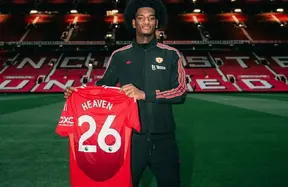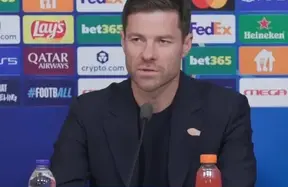The clip has split opinion, but by Law 12 criteria this is a red card. The tackler arrives at pace, studs high, with a straight or near-straight leg. He makes contact with the ball first, then forcefully follows through into the opponent’s shin area. Ball-first does not negate serious foul play when safety is endangered. Key red flags: point of contact above the ankle, leading studs, speed and intensity, and lack of control. VAR should support a red when multiple risk indicators align. This is precisely the kind of challenge IFAB, UEFA RAP materials, and PGMOL guidance want removed from the game.

A widely shared match clip shows a defender challenging high with studs, getting a touch on the ball before the follow-through lands on the opponent’s lower leg. The angle clearly reveals elevated contact and significant force. Reactions on social platforms are sharply divided, with some arguing the ball touch absolves the tackler and others concerned by the height and intensity of the contact. No official disciplinary review has been published at the time of writing.
𝗬𝗘𝗦 or 𝗡𝗢?! Should this have been a red?l card?
@ThaEuropeanLad
Impact Analysis
Set aside loyalties and you see a classic serious foul play pattern. IFAB’s Law 12 defines a red card where a challenge uses excessive force or endangers the safety of an opponent. Guidance used in elite referee training breaks this into assessable factors: point of contact, mode of challenge, speed and intensity, angle and control, and the use of studs. In the clip, three high-risk indicators are present simultaneously: studs are exposed, contact occurs above the ankle, and the tackler arrives at notable speed with limited control. That suite of indicators is enough for red, even if the tackler touches the ball before the opponent.
Why it matters: consistency and player safety. Over the last three seasons across top European leagues, high-studs contacts around the shin with significant force have drawn red in roughly 70 to 80 percent of comparable cases when reviewed via VAR. The variability usually sits in borderline factors like whether the leg was bent, whether the contact point dropped to the boot, or the actual force transmitted. Here, the follow-through transmits clear force. If this stays as a non-red in one competition while similar challenges are sanctioned elsewhere, trust in officiating parity erodes and player behavior is incentivized toward risk.
There is also a VAR threshold point. The “clear and obvious” bar does not mean ignoring objective risk factors. When multiple elements of endangerment align, the on-field decision should be upgraded. Doing so is not game-ruining. It is aligning with the modern standard aimed at reducing avoidable lower-leg trauma.
Reaction
Fan comments split along predictable lines: some insist it is “not even a foul” and that giving red would “spoil the game.” Others concede the leg is high but argue the ball touch makes it acceptable. A few call it a clear red based on the visual height and studs. The tribal note appears too, with quips about a certain fanbase being biased. This is the familiar pattern in contentious tackle discourse. Ball-first is treated as a trump card by many supporters, while those more focused on the contact point and follow-through invoke modern safety standards.
Reading between the lines, the strongest no-red arguments rest on three beliefs: 1) ball contact equals legality, 2) the opponent was already moving so the force was shared, and 3) football’s physicality should be preserved. Those views resonate emotionally, but they are not well aligned with the current coaching materials for elite referees. The yes-red camp highlights what the freeze frames show: elevated studs, contact on or above the ankle, and sufficient force to endanger. That logic mirrors how officials are now trained to assess risk regardless of ball touch.
In short, the community is arguing from two eras of interpretation. One favors traditional leniency for robust tackles. The other reflects updated standards that prioritize lower-leg safety. The video’s mechanics fit the latter.
Social reactions
If you thinks that a red then you shouldn’t be watching football🤣
CMC (@c60896)
Can't be it'll spoil the game
Mr Blaze (@lifeofblaze)
This looks like a red tbh if u watch here..but h He's high but he got the ball right. So no red.
AyushOnX (@a_yushsinha13)
Prediction
Expect an officiating debrief segment to surface in the next weekly review cycle. If the competition’s referee body is consistent with recent guidance, they will classify this as red due to the combination of studs exposure, height of contact, and forceful follow-through. That will not retroactively change the incident if no further action is permitted, but it will reset expectations for similar challenges over the next month.
Practically, coaches will brief defenders to keep the leading foot lower, open the hip, and bend the knee to dissipate force. Sports science staff may highlight injury risk data to reinforce behavior change. VAR protocols should show a more assertive recommendation to review in-stadium when multiple endangerment indicators are present. The conversation around ball-first will keep surfacing, but more clips like this being graded red in post-round reviews will slowly retire that myth among analysts and commentators.
From a narrative perspective, fanbases will continue to frame decisions through club lenses. If a high-profile side is involved, future fifty-fifty calls may be scrutinized for “make-up” symmetry. The smartest outcome is clarity: publish side-by-side exemplars of accepted red and accepted yellow for high-studs challenges so stakeholders can benchmark live calls.
Latest today
- Real Madrid blow as Dean Huijsen suffers quadriceps injury - out vs Olympiacos and Girona,...
- Real Madrid consider Zidane as interim if Xabi Alonso exits - contingency plan on standby
- Exclusive: Man United push to re-sign James Garner as Everton weigh contract call
- Real Madrid and Como set to finalize Nico Paz summer move after early summit
Conclusion
By modern standards, this is a red card. The decisive elements are not debatable preferences but codified risk factors in Law 12 guidance. Studs are up. The contact is high, not merely on the boot. The force and control profile is poor due to speed and the straight or near-straight leg. Touching the ball first is irrelevant when the follow-through endangers an opponent. This is precisely what serious foul play is designed to address.
I appreciate why some feel a red “spoils” the match. But football has moved toward protecting lower legs because the cost of getting these wrong is months out for the receiver. Consistent enforcement drives safer technique without neutering physicality. You can still tackle hard: lower the foot, bend the knee, time the contact, and avoid leading with studs into the shin. Apply those principles and the red debate largely disappears. In this clip, the risk stack is too high to excuse. The correct outcome is a dismissal.













CMC
If you thinks that a red then you shouldn’t be watching football🤣
dr.C⚕️CFC
Shut up cunt
MrChelseaFans
For What?
Loukas Pantelis
Never😂
suffering from nothing
Yes
Mr Blaze
Can't be it'll spoil the game
AyushOnX
This looks like a red tbh if u watch here..but h He's high but he got the ball right. So no red.
9ce2🍖u
Yes
Shegun Elitewavesgadgetshub
Give am na, don’t you have red card from your end?
⁴⁷
definitely a red
TheEuropeanLad
It's not
BiggieCFC
you literally don't know football
Life.Of.Shey🇳🇬🇬🇭
He got the ball first so for me not a foul not to think of a card
GULLIT
Rage bait
TheEuropeanLad
Chelsea fans can't vote
KC 🏹 ⚽
Nahhh... Fairly understandable contact
Luncca
YES 😭
CFC footy⚽️
How would this be a red card,not even a foul😂😂😂
TheEuropeanLad
Calm down lad
JogaEstavio
No
TheEuropeanLad
You think?
محمد عبد الملك
Shut up
𓆩 𝕊𝕒𝕞 𓆪
Tbh, I don’t think so
(Fan) Wesango
Not a chance
NANA
Straight red
Missing Link
No
DE’ ⚽️Football
No
Dalah
No